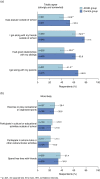Daily life impairments associated with childhood/adolescent attention-deficit/hyperactivity disorder as recalled by adults: results from the European Lifetime Impairment Survey
- PMID: 24571924
- PMCID: PMC4411647
- DOI: 10.1017/S1092852914000078
Daily life impairments associated with childhood/adolescent attention-deficit/hyperactivity disorder as recalled by adults: results from the European Lifetime Impairment Survey
Abstract
Introduction: The Lifetime Impairment Survey, conducted in Europe, assessed impairment and symptoms of attention-deficit/hyperactivity disorder (ADHD) in childhood, and experiences of ADHD diagnosis and treatment, as recalled by adults.
Methods: Adults with ADHD and without ADHD (control group) were invited to participate in an internet-based survey and report on their childhood experiences. History of ADHD diagnosis was self-reported. Groups were compared using impairment and symptom scales.
Results: Overall, 588 adults with ADHD and 736 without ADHD participated. Mean (standard deviation [SD]) age at diagnosis of ADHD was 20.0 (12.6) years (median 18.0) following consultation with 3.8 (5.1) doctors (median 2) over 44.6 (69.3) months (median 17.0). A total of 64.1% (377/588) of adults with ADHD reported frustration or difficulties during the diagnostic process. The ADHD group had a higher mean (SD) score versus control for general (3.3 [1.2] vs 2.1 [1.2]; p < 0.001) and school impairment (2.8 [0.7] vs 2.3 [0.6]; p < 0.001) but not home impairment (2.1 [0.5] for both groups). Discussion The survey demonstrated that ADHD had a negative impact on all aspects of childhood investigated, as recalled by adults.
Conclusions: These data provide insights into childhood impairments and identify areas for improvement in the management and treatment of ADHD.
Keywords: treatment.
Figures



Similar articles
-
Daily life impairments associated with self-reported childhood/adolescent attention-deficit/hyperactivity disorder and experiences of diagnosis and treatment: results from the European Lifetime Impairment Survey.Eur Psychiatry. 2014 Jun;29(5):316-23. doi: 10.1016/j.eurpsy.2013.10.007. Epub 2013 Dec 16. Eur Psychiatry. 2014. PMID: 24355601
-
[Attention-deficit/hyperactivity disorder in childhood/adolescence and impairments associated with daily life: French data from the European Lifetime Impairment Survey].Arch Pediatr. 2014 Dec;21(12):1283-92. doi: 10.1016/j.arcped.2014.08.035. Epub 2014 Oct 7. Arch Pediatr. 2014. PMID: 25300717 French.
-
Impact of attention-deficit/hyperactivity disorder on the lives of Italian children and adolescents: data from the European Lifetime Impairment Survey.Minerva Pediatr. 2015 Oct;67(5):427-36. Minerva Pediatr. 2015. PMID: 26377782
-
[The course of attention deficit hyperactivity disorder (ADHD) over the life span].Psychiatriki. 2012 Jun;23 Suppl 1:49-59. Psychiatriki. 2012. PMID: 22796973 Review. Greek, Modern.
-
Practical considerations for the evaluation and management of Attention Deficit Hyperactivity Disorder (ADHD) in adults.Encephale. 2020 Feb;46(1):30-40. doi: 10.1016/j.encep.2019.06.005. Epub 2019 Oct 11. Encephale. 2020. PMID: 31610922 Review.
Cited by
-
Time of onset and/or diagnosis of ADHD in European children: a systematic review.BMC Psychiatry. 2021 Nov 16;21(1):575. doi: 10.1186/s12888-021-03547-x. BMC Psychiatry. 2021. PMID: 34784913 Free PMC article.
-
The Effects of Spinal Manipulation on Oculomotor Control in Children with Attention Deficit Hyperactivity Disorder: A Pilot and Feasibility Study.Brain Sci. 2021 Aug 6;11(8):1047. doi: 10.3390/brainsci11081047. Brain Sci. 2021. PMID: 34439666 Free PMC article.
-
The socioeconomic burden of adult attention-deficit/hyperactivity disorder in Spain.Glob Reg Health Technol Assess. 2024 Apr 5;11:82-93. doi: 10.33393/grhta.2024.2697. eCollection 2024 Jan-Dec. Glob Reg Health Technol Assess. 2024. PMID: 38601072 Free PMC article.
-
Neurocognitive Predictors of ADHD Outcome: a 6-Year Follow-up Study.J Abnorm Child Psychol. 2017 Feb;45(2):261-272. doi: 10.1007/s10802-016-0175-3. J Abnorm Child Psychol. 2017. PMID: 27395390 Free PMC article.
-
Mainstreaming adult ADHD into primary care in the UK: guidance, practice, and best practice recommendations.BMC Psychiatry. 2022 Oct 11;22(1):640. doi: 10.1186/s12888-022-04290-7. BMC Psychiatry. 2022. PMID: 36221085 Free PMC article.
References
-
- Polanczyk G, de Lima MS, Horta BL, Biederman J, Rohde LA The worldwide prevalence of ADHD: a systematic review and metaregression analysis. Am J Psychiatry. 2007; 164(6): 942–948. - PubMed
-
- Buitelaar JK, Barton J, Danckaerts M, et al. A comparison of North American versus non-North American ADHD study populations. Eur Child Adolesc Psychiatry. 2006; 15(3): 177–181. - PubMed
-
- Dopfner M, Steinhausen HC, Coghill D, et al. Cross-cultural reliability and validity of ADHD assessed by the ADHD Rating Scale in a pan-European study. Eur Child Adolesc Psychiatry. 2006; 15(Suppl 1): I46–I55. - PubMed
Publication types
MeSH terms
LinkOut - more resources
Full Text Sources
Other Literature Sources
Medical

